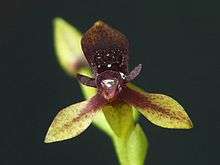Stellilabium
| Stellilabium | |
|---|---|
 | |
| Stellilabium andinum | |
| Scientific classification | |
| Kingdom: | Plantae |
| (unranked): | Angiosperms |
| (unranked): | Monocots |
| Order: | Asparagales |
| Family: | Orchidaceae |
| Subfamily: | Epidendroideae |
| Tribe: | Maxillarieae |
| Subtribe: | Telipogoninae |
| Genus: | Stellilabium Schltr. (1914) |
| Species | |
|
| |
Stellilabium is a small genus in the orchid family (Orchidaceae).
The name is derived from the Latin words stella (star) and labium (lip), referring to the star-like bristles on the lip.
This seldom-seen, neotropical genus occurs from Costa Rica to Venezuela and Western South America as epiphytes on twigs of guava trees in extremely wet tropical forest habitats at elevation between 1400–2500 m.
They are characterized by a short stem with extensive roots, and leaves that are folded lengthwise. The lateral inflorescence gives a raceme or a panicle with few to many miniature to small (from a few mm. to 1 cm), resupinate flowers. The distinct column has an elongate, rostellar beak. There are four pollinia.
Stellilabium jostii practices pollination by deceit by imitating the genitalia of a female fly. The hairs are perfectly engineered to stop the airflow of the wings of the fly, so as to stick a maximum of pollen on the fly.
This genus has been split in the past from the genus Telipogon on morphological grounds (smaller flowers than in Telipogon). But, according to N.H. Williams of the University of Florida, this genus should be remerged with the genus Telipogon. He came to this conclusion on genetic grounds (Botany 2005 conference, Austin, Texas)
Species
- Stellilabium aciculare Dressler (1999) (Costa Rica toi Panama)
- Stellilabium alticola Dodson & R.Escobar (1998) (Venezuela to Peru)
- Stellilabium anacristinae Pupulin (2003) (Costa Rica)
- Stellilabium andinum (L.O.Williams) Garay & Dunst. (1979) (Venezuela to Ecuador)
- Stellilabium astroglossum (Rchb.f.) Schltr. (1914) (Ecuador, Peru)
- Stellilabium atropurpureum P.Ortiz (2004) (Colombia)
- Stellilabium barbozae J.T.Atwood & Dressler (1995) (Costa Rica)
- Stellilabium bennettii (Dodson & R.Escobar) Christenson (2001) (Peru)
- Stellilabium bergoldii (Garay & Dunst.) Carnevali & G.A.Romero in G.A.Romero & G.Carnevali (2000) (Venezuela)
- Stellilabium boliviense R.Vásquez & Dodson (1982) (Bolivia)
- Stellilabium bullpenense J.T.Atwood (1989) : Bullpen Orchid (Costa Rica)
- Stellilabium butcheri Dressler (1999). (Panama)
- Stellilabium campbelliorum J.T.Atwood (1989) (Costa Rica)
- Stellilabium erratum Dressler (2001) (Costa Rica)
- Stellilabium fortunae Dressler (1999) (Panama)
- Stellilabium hirtzii Dodson (1984) (Ecuador)
- Stellilabium ibischii R.Vásquez (1998) (Bolivia)
- Stellilabium jostii Dodson (2004) (Ecuador)
- Stellilabium monteverdense J.T.Atwood (1989) (Costa Rica)
- Stellilabium morii Dressler (1999) (Panama)
- Stellilabium pampatamboense Dodson & R.Vásquez (1989) (Bolivia)
- Stellilabium perlobatum Senghas (1994) (Bolivia)
- Stellilabium peruvianum D.E.Benn. & Christenson (1998) (Peru)
- Stellilabium pogonostalix (Rchb.f.) Garay & Dunst. (1961) (Ecuador)
- Stellilabium pseudobulbosum D.E.Benn. & Christenson (1998) (Peru)
- Stellilabium smaragdinum Pupulin & M.A.Blanco (2002) (Costa Rica)
- Stellilabium tsipiriense Pupulin (2003) (Costa Rica)
- Stellilabium vulcanicum Dodson & Hirtz (2004) (Ecuador)
References
- Braas LA, Luckel E (1982). "Die Gattungen mit Bestimmungsschlussel der Telipogon- Verwandtschaft (Subtribus Telipogoninae Schltr.): Telipogon H.B.K., Trichoceros H.B.K., Stellilabium Schltr., Dipterostele Schltr., Darwiniella Braas et Luckel". Orchidee. 33 (5): 170–176.
- Dressler RL. (1999). "A reconsideration of Stellilabium and Dipterostele". Harvard Pap. Bot. 4 (2): 469–473.
- Sanchez Sanchez E. (2002). "Telipogons and their allies". Orchid Dig. 66 (1): 6–12.
![]() Media related to Stellilabium at Wikimedia Commons
Media related to Stellilabium at Wikimedia Commons